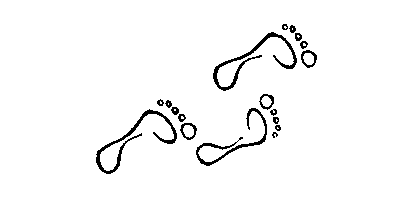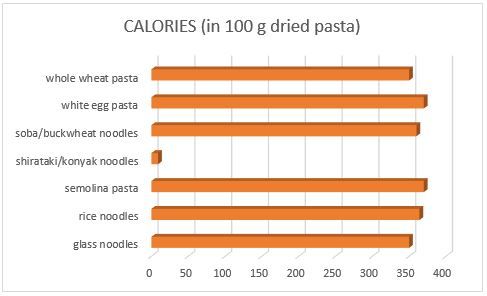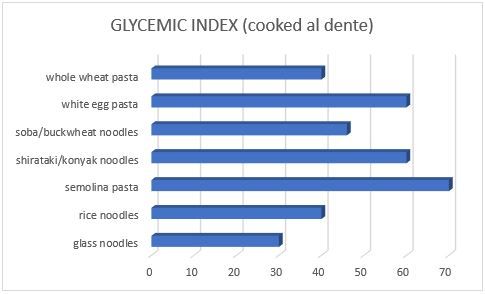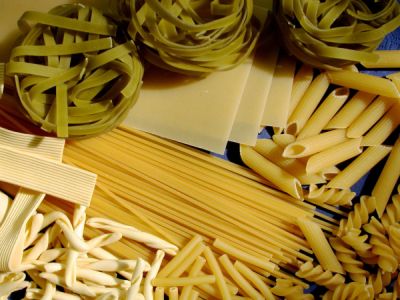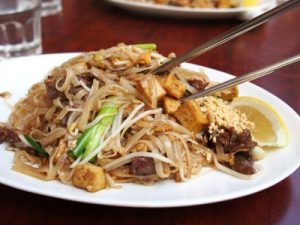Pasta – if it’s only bad simple carbs, very caloric and without any value, why have it become runners’ favorite fuel? Why is the legendary pre-run meal called „pasta party” instead of e.g. „rice party” or „potato party”? Where’s the catch?
There are loads of myths around pasta. Nevertheless, it’s loved and recommended by runners and other athletes both before and after training or competitions. What is it all about?
As for pasta adoration, a few simple reasons come to mind. First of all, no other product (groats, rice, potatoes) offers so many varieties of tastes and mixes as pasta – hot, cold, soup or salad, roasted, sweet or sour. Different shapes also allow for lots – you can stuff it, put betweem layers of sauce or vegetables, pick with a spoon from the soup or wind on a fork. It is easy and fast to prepare, is versatile, nourishing, convenient and cheap.
And how about all these myths and nutritional values?
PASTA MYTHS
- PASTA IS EMPTY CALORIES – pasta is made from flour, so it all depends on what flour was used. Good pasta is made from hard durum wheat (i.e. semolina) – it’s the healthiest wheat flour, rich in vitamins (from group B, vitamin E) and minerals (eg calcium, potassium, iron, phosphorus, copper, manganese, zinc ). If we choose good pasta, it will certainly not be empty calories, but a whole bunch of nutrition.
- PASTA IS VERY CALORIC – in 100g of dry pasta we find about 350 kcal. However, there’s no need to panic because the pasta during cooking absorbs a large amount of water (the water does not contain calories, so it doesn’t raise the caloric value of the dish) and increases its volume 2-3 times. Therefore, simply use less pasta or measure pasta after cooking – it contains only 150 kcal in 100g this way.
- MAKARON IS FATTENING – Look at any menu in the restaurant. Among 10 pasta dishes, you’ll be lucky to find such without fat sauce – cream, butter or cheese one. And it’s the additives that determine whether it’s a light, energetic meal or a calorie bomb, after which we barely get up from the table. Cream sauce and a solid serving of Parmesan cheese are the real enemy, not the pasta itself. If you combine pasta with vegetables, and instead of the sauce, add a spoon of good oil or pesto, the dish will be much healthier.
- CARBOHYDRATES ARE UNHEALTHY – According to current dietary guidelines, we don’t have to consume as much protein as previously claimed. We should reduce the proportion of saturated animal fats, but increase the amount of fiber and complex carbohydrates. As a matter of fact, this is exactly a description of pasta composition. It contains about 70% carbohydrates, 10% protein, is rich in fiber and minerals. Whole wheat pasta helps keep stable glucose levels in the body and has a positive effect on kidney and liver function. With a good selection of additives, it’s a balanced meal. It’s also a favorite product of many athletes (a good source of energy).
NUTRITIONAL VALUES
- Balanced energy – carbohydrates provide us with glucose, the essential fuel for the brain and muscles. Pasta is an excellent source of complex carbohydrates that provide slow energy release. Unlike simple sugars, which offer a quick but short-lived energy boost, pasta helps maintain constant energy levels.
- Vitamins and minerals – pasta is cholesterol free and has very little sodium. Richer varieties of pasta are a good source of essential nutrients, including iron and several B vitamins. Whole wheat pasta, in 100 g, provides up to 25% of daily fiber requirement.
- Good source of fiber – most types of pasta is very rich in fiber, which gives a sense of satiety, supports digestive function, lowers bad cholesterol levels and nourishes the useful intestinal flora.
- Low glycemic index – Pasta (other than white wheat pasta) has a low glycemic index (IG), so it doesn’t cause rapid rise in blood glucose.
- It comes in many varieties and is easy to prepare – the large variety of pasta types makes it possible for anyone to find the one suitable for them. Pasta preparation takes just a few minutes and will work in any taste configuration.
HOW TO DEAL WITH PASTA?
Classic pasta, depending on how we deal with it, may aid our health, but also harm us. It’s not just the pasta itself that’s bad, fattening and generally bad(!) – it’s what we do with it.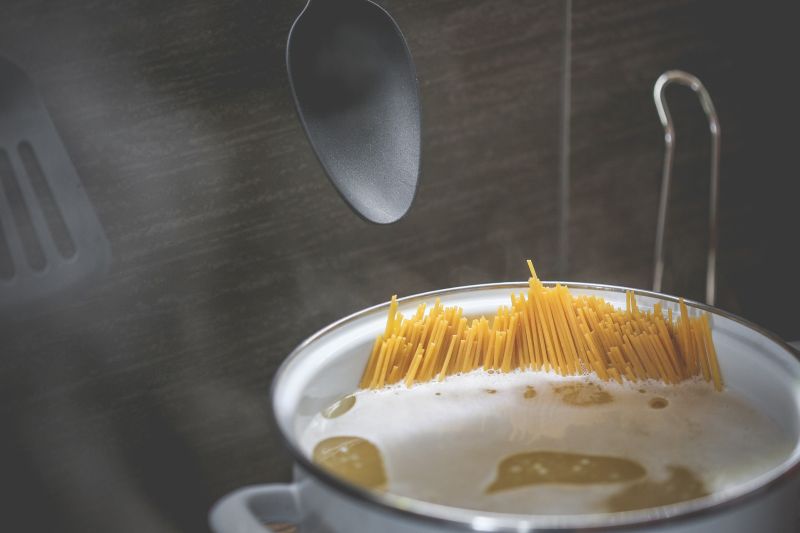
- Pasta produced in high temperatures is covered with a special protective layer that slows the starch gelanization. This technique is used e.g. in the production of spaghetti and some other long pasta types. Ravioli, farfalle, elbows and other pasta shapes must be handmade and therefore have a higher glycemic index (despite the same composition as spaghetti).
- Cooking pasta al dente (slightly hard and elastic, cooked about 5-6 minutes) helps keep the glycemic index at a lower level. Al dente pasta will have, for example, IG 60, while cooked longer will already have IG 75.
- Pasta should be cooked in large amounts of water, which ensures thorough and uniform cooking and prevents sticking. With enough water you don’t need to add oil to it. Good pasta doesn’t contain salt, so we add a lot of it to the water in which we cook pasta. Almost all salt is then poured out with water, so don’t be afraid to add a solid spoon of it. In addition, after cooking, don’t rinse pasta with running water. Such a treatment removes the protective layer of starch, salt and taste.
- The content of protein and fiber affects the rate of digestion of carbohydrates – therefore whole grains are actually very beneficial for our diet. Gluten (a vegetable protein) and high fiber content are responsible for limiting the secretion of amylase (starch-digesting enzyme), resulting in stable and slower access to energy and lower blood glucose levels.
- Light sauces, such as tomato, mushroom, etc. will be a good and tasty addition to pasta. Well-chosen vegetables often no longer require any sauces (although you can sprinkle the dish with a good olive oil). Such a dish certainly will not be a calorie bomb, as would be a pasta with fat cheese sauce and meat. Let’s remember that it’s the additions that define whether after dinner we can run a marathon or we crawl away from the table.
PASTA TYPES
WHITE PASTA
White pasta is the most common type of pasta on the store shelves. It can be produced in several different ways – from different types of flour, with or without eggs.
The most classic pasta, a real Italian wouldn’t be ashamed of, is made from semolina, or hard wheat flour (Durum). It has a yellow or cream-yellow color, and should only contain flour and water. It’s surface should be slightly rough – thanks to it, the pasta holds the sauce well.
White pasta can also be produced from ordinary wheat flour – it’s a bit worse kind of pasta, often salted and with eggs (Durum wheat does not need the addition of eggs to get the appropriate taste and elasticity of the dough).
If you want to eat a healthy pasta, it is worth to use spaghetti or tagliatelle with vegetables and a little oil or pesto. Avoid cheese and cream sauces.
IN RUNNER’S KITCHEN:
Pasta is a basic product of Italian cuisine, widespread throughout the world. In the runner’s diet, white pasta would be a perfect meal shortly before the competition or right after the competition, at which time you need to quickly supply the muscles with high doses of energy. In addition, you can eat it cold, in salads – in this form there is so called resistant starch, making the carbohydrates harder for digestion. The best additions include light tomato or mushroom sauce and any combination of vegetables.
WHOLE WHEAT PASTA
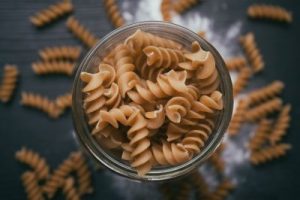 Whole Grain Pasta is darker colored pasta, made from various kinds of flour. It has a more distinct taste than the white pasta and is much more valuable. It contains more fiber and protein, has a lower glycemic index, which is why it is more satiating and preferred by people aiming at healthy eating. More and more pasta of this type appears on our shelves – you can already see whole wheat pasta with Durum flour, but also rye and spelt, and with the addition of other flours. On a daily basis it will always be a much better option than white pasta, whether we make salad, spaghetti or casserole.
Whole Grain Pasta is darker colored pasta, made from various kinds of flour. It has a more distinct taste than the white pasta and is much more valuable. It contains more fiber and protein, has a lower glycemic index, which is why it is more satiating and preferred by people aiming at healthy eating. More and more pasta of this type appears on our shelves – you can already see whole wheat pasta with Durum flour, but also rye and spelt, and with the addition of other flours. On a daily basis it will always be a much better option than white pasta, whether we make salad, spaghetti or casserole.
IN RUNNER’S KITCHEN:
As with pasta, it is best to combine it with vegetables or pesto. In the case of whole wheat pasta, you can reach for all the shapes (in restaurants we usually get penne), because such pasta contains much more fiber that slows down the digestion of carbohydrates. Except for the situation just before the run and immediately after the run, this pasta is most desirable at all other times – thanks to fiber and higher protein content it will be practicall at any time of the day.
RICE NOODLES
Rice noodles are a traditional Chinese product, although we usually associate it with Thai cuisine – nowadays, available in virtually every store. It’s extremely easy to prepare because it doesn’t require cooking. Just put into boiled water, cover and wait a few minutes (as described on the package). It is a gluten-free product, has less calories than classic pasta, albeit a higher glycemic index. The taste is very neutral.
IN RUNNER’S KITCHEN:
Rice noodles are used in many eastern cuisines. The most popular dish made of this pasta is Pad Thai – a traditional street food known from Thailand. We can also see it as an addition to Malaysian curry noodles or spicy Thai Tom Yum soup. In fact, it will work as a substitute for any pasta, especially for people intolerant to gluten. Also, runners will benefit from this gluten-free, slightly lighter version of the pasta for the stomach. The speed and ease of preparation will surely be appreciated by those who need to prepare to run in poor conditions.
UDON NOODLES
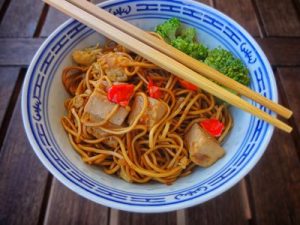 This is a kind of thick noodles made from wheat flour – something on the border between pasta and noodles. Widely used in Japanese cuisine, most commonly found as an addition to all sorts of soups. It also works very well in stir-fry dishes. Udon is cooked quickly, in salted water.
This is a kind of thick noodles made from wheat flour – something on the border between pasta and noodles. Widely used in Japanese cuisine, most commonly found as an addition to all sorts of soups. It also works very well in stir-fry dishes. Udon is cooked quickly, in salted water.
IN RUNNER’S KITCHEN:
This is the most commonly used pasta in clear broths, but also traditional dishes such as Ramen or fried with vegetables. For runners, chinese noodles are rather a „cheat-meal” varieties. They have less protein and higher IG, and on the countryside it’s easier to get spaghetti anyway ;)
GLASS NOODLES
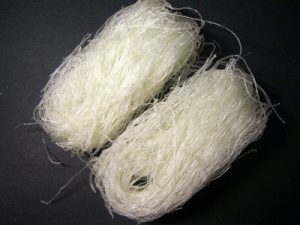 Although recently soybean pasta occured on the store shelves, the original glass noodles is not produced at all from soybeans, but from the starch of mung bean (or sometimes from potato starch). After cooking it becomes transparent (hence the popular name „glass noodles”). It is a gluten-free product with a low glycemic index, contains about 10% protein and has only a small amount of fat (only in mung beans version), but has only trace amounts of fiber. Just like rice noodles, it doesn’t require cooking – just put into boiled water and set aside for a few minutes under cover. Most commonly found in the form of thin threads.
Although recently soybean pasta occured on the store shelves, the original glass noodles is not produced at all from soybeans, but from the starch of mung bean (or sometimes from potato starch). After cooking it becomes transparent (hence the popular name „glass noodles”). It is a gluten-free product with a low glycemic index, contains about 10% protein and has only a small amount of fat (only in mung beans version), but has only trace amounts of fiber. Just like rice noodles, it doesn’t require cooking – just put into boiled water and set aside for a few minutes under cover. Most commonly found in the form of thin threads.
IN RUNNER’S KITCHEN:
Glass noodles are mainly used in Vietnamese and Chinese cuisine. Suitable for both hot dishes and salads. Works well as an addition to soups, spring rolls or served with vegetables and tofu. Instead of cooking, you can fry it directly on hot oil.
SOBA (BUCKWHEAT) NOODLES
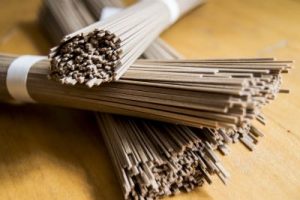 Soba is not a wheat pasta – it is obtained from buckwheat flour. It comes in the same form as spaghetti, but has a darker brown color and a very expressive flavor and aroma. It is the only dark pastsa among all eastern varieties and it is the most nutritious – it is a source of B vitamins, vitamin E and micronutrients like magnesium, potassium, iron and zinc. It also has a low glycemic index, contains the most fiber, and is a gluten-free product (provided it does not contain added wheat flour). In taste it resembles whole wheat pasta rather than buckwheat, so people who do not like buckwheat dont’ have to be afraid of it.
Soba is not a wheat pasta – it is obtained from buckwheat flour. It comes in the same form as spaghetti, but has a darker brown color and a very expressive flavor and aroma. It is the only dark pastsa among all eastern varieties and it is the most nutritious – it is a source of B vitamins, vitamin E and micronutrients like magnesium, potassium, iron and zinc. It also has a low glycemic index, contains the most fiber, and is a gluten-free product (provided it does not contain added wheat flour). In taste it resembles whole wheat pasta rather than buckwheat, so people who do not like buckwheat dont’ have to be afraid of it.
IN RUNNER’S KITCHEN:
Soba noodles are often found in Thai and Chinese cuisine. It is popular addition to soups (so called kake soba), a component of cold salads (zaru soba), but also typical hot dishes. Successfully replace traditional spaghetti with it, both white and whole wheat. As the most valuable (and my favorite), it will certainly satisfy many runners, especially fried with vegetables or simply with soy sauce and sesame.
SHIRATAKI (KONYAK) NOODLES
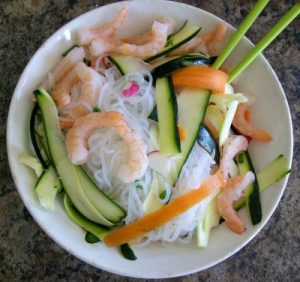 Super-dietetic pasta, which has recently become a hit of fashion. It is made from konjac flour, containing fiber called glucomannan. This pasta delivers only 6kcal/100g! In addition to facilitating slimming (thanks to minimal calorie), it further helps to maintain a stable blood sugar level, regulates intestinal function, lowers bad cholesterol levels, and fights hypertension. It is gluten-free and produced without the use of eggs, so it is suitable for vegans. There is only one drawback – it is expensive and so far, very hard to get in the stationary stores. If you find it, it’s in the stores with a well-developed healthy food or cuisines of the world departments.
Super-dietetic pasta, which has recently become a hit of fashion. It is made from konjac flour, containing fiber called glucomannan. This pasta delivers only 6kcal/100g! In addition to facilitating slimming (thanks to minimal calorie), it further helps to maintain a stable blood sugar level, regulates intestinal function, lowers bad cholesterol levels, and fights hypertension. It is gluten-free and produced without the use of eggs, so it is suitable for vegans. There is only one drawback – it is expensive and so far, very hard to get in the stationary stores. If you find it, it’s in the stores with a well-developed healthy food or cuisines of the world departments.
IN RUNNER’S KITCHEN:
Shirataki noodles come in various shapes and can be used as a substitute for any of the aforementioned pasta. Runners can benefit from it when they try to get rid of excess kilograms. Later on, we’re rather more interested in excess of energy than lack of it, are we not? ;)
If you find this article interesting, share it with others using the social media buttons below the article. If you don’t want to share, maybe at leas like it? :-)
